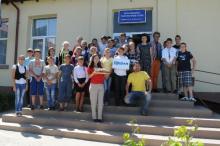SONDAR Network expands Contacts towards the Romanian Region of Dobrudja
From May 3rd to May 10, a technical field trip on soil conservation and soil awareness took place to the Romanian region of Dobrudja with its two administrative units of Tulcea and Constanta. Developments which we nowadays complain of in Lower Austria, for instance sealing of urban or suburban areas, accompanied by a deactivation of biological processes in soils, or deprivation of peripheral areas and neglect of soil cultivation take place much more quickly in the former communist countries of South-East Europe. The development towards modern living conditions, which has possibly lasted for 60 years in Lower Austria, has occurred more quickly in the region of Dobrudja, in approx. 20 years. The changes in the social system are even more serious. The population benefits only in part, and mainly in towns, from accession to the EU. Especially the young take advantage of the opportunity of improved working conditions in the foreign European countries. Thus, Romania has lost five per cent of its population since 2001 (http://epp.eurostat.ec.europa.eu/). The local migration to the centers of the regions is considerably high, and especially structurally backward villages face their collapse.
A special example of this development is the Romanian Danube Delta. While a high level of employment was reached in communist times, nowadays the majority of the remaining population depends on transfer benefits. The participants of this field trip made an on-site inspection in the village of Sfistofca, which is inhabited by the Russian e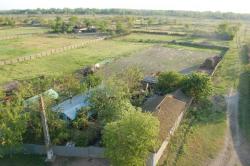 thnic group of Lipovans, a village, in which more than 1,000 persons lived after World War II, nowadays, however, there are only 78 inhabitants left. Within two generations, degradation has taken place, any further depopulation endangers the maintenance of village life. The group of visitors had an advantage, they were allowed to participate at Easter with the Russian Old Believers or Lipovans, whose relatives were visiting them. Many of the descendants of this village, however, have lost their Russian and have converted to the Romanian Orthodox Church. Their century-old heritage with special rituals and their cultivated tradition will soon be lost. A situation recurring many times in the Danube region. While the Danube Delta provides for species conservation for endangered species, there is still no programme for the variety of numerous ethnical ways of life. As a sign of commitment to the village of Sf
thnic group of Lipovans, a village, in which more than 1,000 persons lived after World War II, nowadays, however, there are only 78 inhabitants left. Within two generations, degradation has taken place, any further depopulation endangers the maintenance of village life. The group of visitors had an advantage, they were allowed to participate at Easter with the Russian Old Believers or Lipovans, whose relatives were visiting them. Many of the descendants of this village, however, have lost their Russian and have converted to the Romanian Orthodox Church. Their century-old heritage with special rituals and their cultivated tradition will soon be lost. A situation recurring many times in the Danube region. While the Danube Delta provides for species conservation for endangered species, there is still no programme for the variety of numerous ethnical ways of life. As a sign of commitment to the village of Sf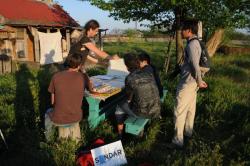 istofca, a painting box with soil colours from Lower Austria was handed over in the house of the local artist. The hope has been expressed that a future painting box with soil colours from the Danube region will also contain the colour of the sandy soil of Sfistofca.
istofca, a painting box with soil colours from Lower Austria was handed over in the house of the local artist. The hope has been expressed that a future painting box with soil colours from the Danube region will also contain the colour of the sandy soil of Sfistofca.
The region of Tulcea is interesting in two respects, from the point of view of soil conservation: On the one hand, in this region the oldest soils of Europe are situated, the Macin Mountains, a part of the Hercynic range, are geologically much older than the Alps and Carpathians, and in millions of years it has been subject to erosion, now at a level of 300m. On the other hand, in this region there are the youngest soils of Europe, those of the Danube Delta, which only has existed for 10,000 years, and wh ich is still expanding. The village of Nufaru near the regional center of Tulcea is advantaged because there are two groups of soils, especially young ones and especially old ones in its municipal area. The European SONDAR network and a Lower Austrian painting box with soil colours contribute that school children in the municipality of Nufaru are now increasingly committed to soil awareness. They would gladly indulge more deeply in this topic and produce their own domestic soil colours, such as this has already happened in South Moravia, Western Slovakia, West Hungary and Lower Austria. This opportunity exists, for the municipality of Nufaru is a precursor in soil conservation, and has already entered the European Land and Soil Alliance ELSA as the first Romanian member. Mayor Danila Ion has confirmed the interest shown by his antecessor Gavrila Tincu, and intends to support future projects.
ich is still expanding. The village of Nufaru near the regional center of Tulcea is advantaged because there are two groups of soils, especially young ones and especially old ones in its municipal area. The European SONDAR network and a Lower Austrian painting box with soil colours contribute that school children in the municipality of Nufaru are now increasingly committed to soil awareness. They would gladly indulge more deeply in this topic and produce their own domestic soil colours, such as this has already happened in South Moravia, Western Slovakia, West Hungary and Lower Austria. This opportunity exists, for the municipality of Nufaru is a precursor in soil conservation, and has already entered the European Land and Soil Alliance ELSA as the first Romanian member. Mayor Danila Ion has confirmed the interest shown by his antecessor Gavrila Tincu, and intends to support future projects.
The unique and virtually single opportunity of development in the Danube Delta is tourism. The variety of species of this landscape, the interaction between land and water, as well as th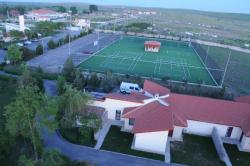 e wealth in natural resources of the Danube Delta have been known for a long time, and are unmatched in Europe. The administration of the Danube Delta with its seat in Tulcea controls observation of the provisions of nature conservation in an area of 3,446 km² in the Romanian part of the Biosphere Reserve in the Danube Delta. The nature conservation area amounts to a total of 4,178 km², 732 km², however are situated in the Ukraine and outside the EU. How development can be achieved, is subject to discussion. For the EU mainly subsidizes huge plants, such as the recently completed Puflene resort in Murighol, which can be reached rather easily and which offers sufficient luxury, while villages such as Sfistofca have no or only rudimental connection to the public road network. The administration of the Biosphere Reserve is in many cases supported by the Danube Delta Inst
e wealth in natural resources of the Danube Delta have been known for a long time, and are unmatched in Europe. The administration of the Danube Delta with its seat in Tulcea controls observation of the provisions of nature conservation in an area of 3,446 km² in the Romanian part of the Biosphere Reserve in the Danube Delta. The nature conservation area amounts to a total of 4,178 km², 732 km², however are situated in the Ukraine and outside the EU. How development can be achieved, is subject to discussion. For the EU mainly subsidizes huge plants, such as the recently completed Puflene resort in Murighol, which can be reached rather easily and which offers sufficient luxury, while villages such as Sfistofca have no or only rudimental connection to the public road network. The administration of the Biosphere Reserve is in many cases supported by the Danube Delta Inst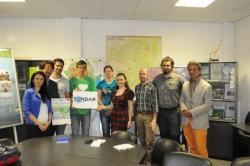 itute, a European Research Institute awarded excellence, through scientific expertise. The participants of this field trip have been informed on current projects in protection against flooding by the spatial planning research group, Ms. Iuliana Nichersu and her colleagues. The SONDAR initiative, Soil Strategy Network in the Danube Region, has been very positively received by the relevant institutions of the region of Tulcea and of the Danube Delta. The wish has been quite clearly expressed to enter a deepened exchange between Lower Austria and Tulcea, and to pursue common goals of the Strategy for the Danube Region in the field of soil conservation within the Working Community of the Danube Regions.
itute, a European Research Institute awarded excellence, through scientific expertise. The participants of this field trip have been informed on current projects in protection against flooding by the spatial planning research group, Ms. Iuliana Nichersu and her colleagues. The SONDAR initiative, Soil Strategy Network in the Danube Region, has been very positively received by the relevant institutions of the region of Tulcea and of the Danube Delta. The wish has been quite clearly expressed to enter a deepened exchange between Lower Austria and Tulcea, and to pursue common goals of the Strategy for the Danube Region in the field of soil conservation within the Working Community of the Danube Regions.
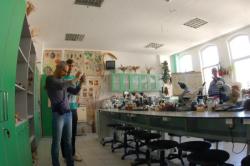
As a conclusion of this field trip, they visited the Ovidius University of Constanta. Prof. Florin Aonofriesei, a microbiologist, who also wrote a textbook on microorganisms in soil and who also participated in a meeting of the Working Community of the Danube Regions in St. Poelten in 2011, guided us through the new campus of this university. In case of need, these premises will also be available for the SONDAR network.
The feedback on this field trip was positive. There is a wish to deepen cooperation and to intensify exchange
on various levels, on an administrative level, on the level of practical implementation of projects and scientific exchange. We hope to be able to comply with this request in the years to come.
Meinhard Breiling, BIENE-Network
Fotos © Meinhard Breiling
04.11.2025
EUSDR PA10: 12th Danube Participation Day in Sarajevo
more ...30.10.2025
Online-Präsentation BBK-Projekt CNSoil - Zwischenergebnisse
more ...07.10.2025
CatchHedge - Potenziale von Hecken im Zeichen des Klimawandels
more ...16.+17.09.2025
32nd Conference of the Danube Region
more ...12.09.2025
Grundlagen der professionellen Bio-Mandel-Produktion
more ...10.09.2025
Agroforst u. Marktgärtnerei, Symbiose
more ...05.09.2025
Regionales Wiesensaatgut gewinnen mit dem Wiesensamenernter
more ...25.06.2025
Feldtag - StripTill im Bio-Mais im Trockengebiet
more ...25.06.2025
Seminar: Wildbienen- und Nützlingsförderung im Biolandbau
more ...24.06.2025
BOKU Green Plate Forum 3.0
more ...24.06.2025
Die Maulbeere - Kultur, Produktion u.Verwendung
more ...17.06.2025
Frühjahrstagung Österr. Gesellschaft für Agrar- und Umweltrecht (ÖGAUR)
more ...13.06.2025
Seminar: Artenvielfalt in Ackerbauregionen fördern
more ...03.06.2025
Seminar: Keine Angst vor der Ackerdistel
more ...03.06.2025
Agroforstsysteme: Anbau-Modelle der Zukunft
more ...20.05.2025
IDM-Generalversammlung 2025
more ...15.05.2025
Seminar: Unkräuter/Beikräuter erkennen und als Zeigerpflanzen nutzen
more ...13.+14.05.2025
Bodenforum Österreich - Frühjahrstreffen
more ...04.05.2025
Tageskurs: Perma-Veggies - Mehrjähriges Gemüse und essbare Stauden
more ...03.05.2025
Waldgärten-Exkursion
more ...



